Imprimer
Articles liés
Artistes
Pierre Michelon
David Legrand
Emmanuelle Chérel
Lundi de Phantom n°11 de Pierre Michelon (5)
Conversation between David Legrand and Emmanuelle Chérel
Examining a speech not made by André Malraux in Cayenne, Pierre Michelon focuses on a signature episode in the history of the departmentalization of French Guyana: the September 1958 referendum on the Constitution of the 5th Repubic. « A small piece of wood » considers this account in all its many versions: according to the Independents, the Communists, the Gaullists, the ministers, or all versions at once. This is the case with Jean Mariema, an important figure in Guyanese militancy, with whom Pierre Michelon constructs this model for a film. For the evening of performance-documentary on Monday, March 31st (Phantom Monday n°11), he collaborates with David Legrand and invites Françoise Vergès and Mathieu K. Abonnenc to share in the discussion. To accompany this work in progress, Pierre Michelon has assembled texts and documents that shed light, each in its own manner, on the different points of his research.
WE KNOW HOW TO LIVE IN UNRESOLVED SPACES AND EVEN HOW TO TAKE PLEASURE IN THEM
Excerpt from an uncompleted interview between David Legrand and Emmanuelle Chérel, concerning the ‘galerie du cartable’s’ ‘Fictive Dialogues’ and conducted between 2009 and 2010, as part of the research project “Concerning a new school”, headed by Michel Aubry and Edith Commissaire, from the Nantes School of Fine Arts.
Emmanuelle Chérel: Michel Aubry wrote the following about your project for a film “La visite des écoles d’art”: “What the film fiction evokes through dialogue is firstly history, which has abandoned methods of artistic instruction, but also the current context of art schools in the western world and their implication in cultural life. Via fictional dialogues, the film considers both artists from the past, generally consecrated by art history, but also current artists, who may in this case be asked to play their own role. The only condition is the staging of their speech which, far from betraying it, gives in more weight than it would have in a sociological investigation or a documentary. The texts of these interviewed figures will always be submitted to them, rewritten and corrected until their accord is granted. If they do not wish to appear in the film, the dialogue may be performed by an actor. Filming corresponds to the publication of their speech. “The Fictional Dialogues” are video films produced by the ‘galerie du cartable’ (and more specifically by David Legrand) who, since 2003, have staged improbable exchanges between artists. We see, for example, Nicolas Poussin and Leonardo da Vinci jogging, the exchanges between Dürer and Beuys in traffic circles in Châteauroux…”.
The fictional dialogue that you are currently writing offers the occasion to analyze your work process. How do you conduct your research of historical (or not) documents and preliminary investigations before writing the scenario?
David Legrand: Between the fictional dialogues written for the ‘galerie du cartable’ and those that I’ve started to write for the fictional film part of this project, my methods are different. In the first case, I write fictional dialogues that borrow from literary history, a particular form, a variety, if you will, of ordinary dialogue: the dialogue of the dead. It is an important variety and a singular invention: it confronts characters from different countries and time, which increases the possible combinations. And as all human vanities destroy each other at the time of death, it’s possible to express the most divergent ideas.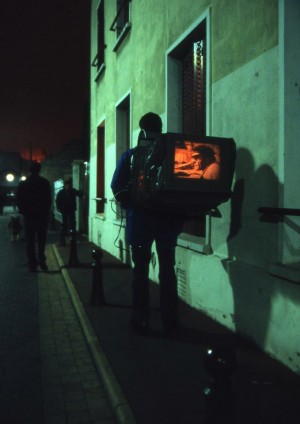
Vidéoportation de la galerie du cartable, rue de Gennevilliers, 2004
Photograph: Laurent Lecat.
I discovered this “genre” at a time when I was searching for a different way (as opposed to the exhibition) to show, reflect on and transmit an artistic practice as a project for living the impossible. I began a period of experimentation of daily life to produce action in opposition to the global evolution of society. By refusing, for example, to spend our life between unemployment stipends and a job. By affirming that the desire for artistic expression is situated there where someone decides to no longer be the slave of a way of living and to create his or her own modes of existence in order to no longer be a victim of them. I wanted to offer a reading of art that implied much more than artistic work and to show that the necessity to live the impossible is nothing less than a new possibility of work for very small groups, so as to generate spaces for imagination that are sites for freedom of imagination. That’s the work of art. And in this perspective, “The Fictional Dialogues” were useful, because they gave me a framework for constructing languages that speak of this possibility for creation via a creative manner of acting, which the film adaption allowed me to show.
So I began by establishing a list of subjects for dialogues which would allow me each time to reunite two famous deceased figures from the history of art or thought, either from different periods or not, and interpreted by living artists or thinkers, in the form of filmed conversations. Since I did not want the dialogues to be improvised, a period of writing was indispensable. For each author, who becomes a character, I search in his texts and writing for the materials that will help me compose his speech, in order to produce an oral text. Looking for the oral material for the texts is my first work.
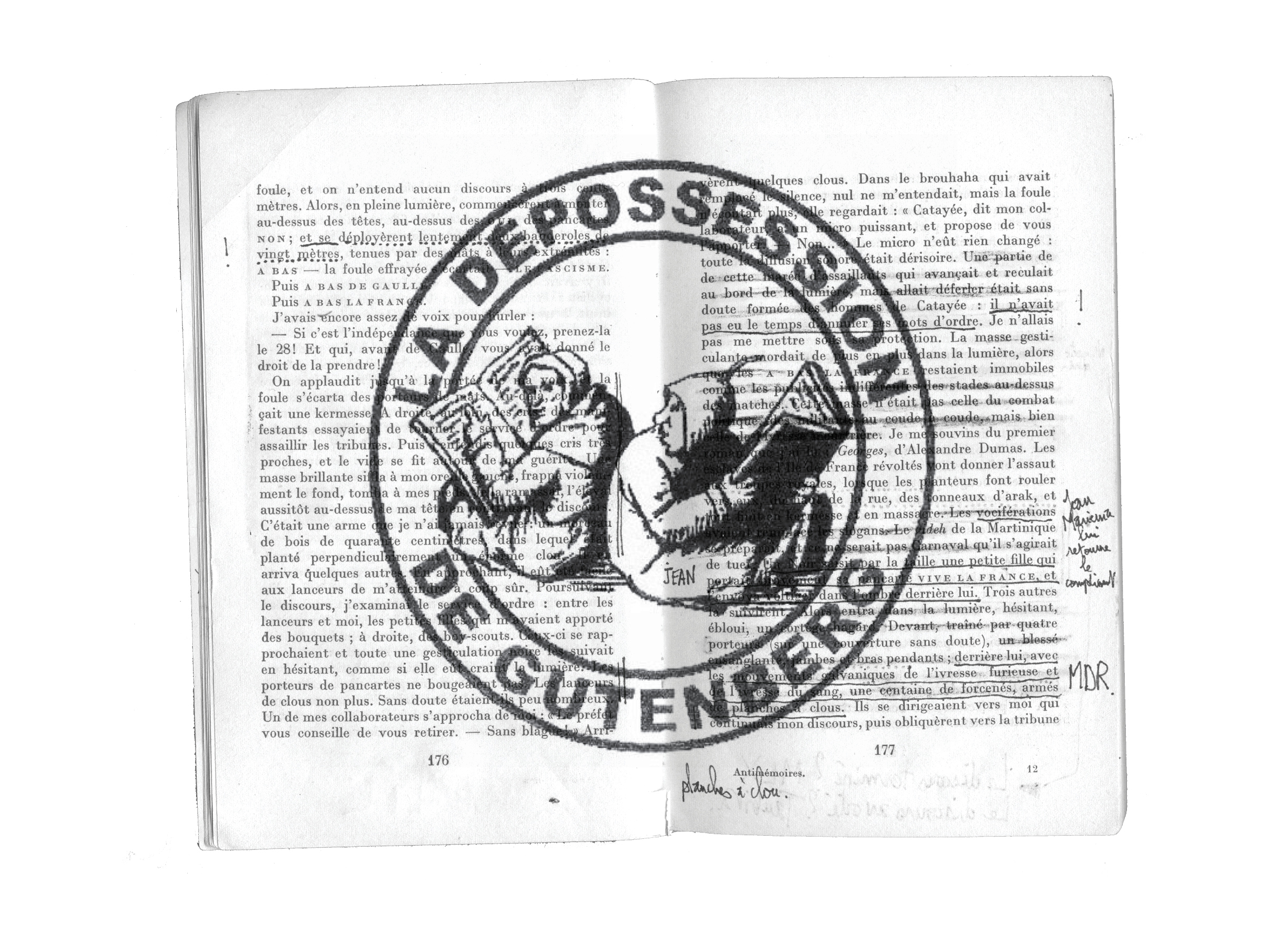
I have to discover the veins of the text. The veins in the block of marble that is the text. In any text, in a sentence, there are veins, just as there are in the stone removed from the quarry! The veins of statement, of logic. To reveal them, you have to pronounce the text, swirl it in your mouth, say it aloud to hear its contents, dynamic, logic, how it functions or quite simply how it reasons. This is why the composition of each protagonist’s speech begins by a rereading of all of the figure’s texts. But I don’t read them as you would a novel, in a linear manner. No, I ingest them, I chew them and spit out pieces. Pieces of sentences, pieces of ideas, pieces of statements. The residue of a reading experience that contains possibilities of new creation, which I accumulate. Then the writing process consists of incorporating this residue in my own writing before arranging them into a dialogue. This is why the process of writing for the film project is different that the fictional dialogues, the original material is not the same, since it involves transposing living, documentary speech into dramatic, and then audiovisual, writing.
E.C.: The fact that you absorb the texts, you swallow them to nourish yourself, is an important gesture. This practice is in opposition to the idea of compilation, but also to the ideas of recovery or duplication, which are very popular now. Your manner of writing implies a physical and mental gesture, which uses, and passes through, and transforms. Eating words, digesting texts and working with the remains makes me think of this phrase from O. Debary: “What will we do with the remains: throw them away, save them, or recycle them? The remains protest, organizing themselves and defying a present that endeavors to forget them without ceremony, without homage.”
To qualify this rereading of historical account that you are attempting, referring to the thinking of Walter Benjamin is inevitable (and very much in vogue today): “What worries me is the question of the relation of works of art to historical reality. In this perspective, there is one thing of which I am sure, and that is that there is no art history.” For Benjamin, no work of art can be deduced from those that preceded it. The succession of works defines a discontinuous temporality, which escapes determinism and the illusion of progress. In his introduction to The origin of German baroque drama, he presents a discontinuous vision of knowledge defined by a multiplicity of points of view that are not cumulative and favors a synchronous approach to history. Aesthetics offers him the model for a specific historicity, not regulated by the principle of causality but founded on the insertion of each work of art in a zone of autonomous temporality, engendering its own present, its own past and its own future. These zones of temporality, independent each from the other, cannot be added together, nor do they form together a homogenous evolution, but on the contrary, they define a history made up of a succession of discontinuous and discreet semantic unities. “The specific historicity of works of art is not manifested in art history but in their interpretation.” The past of a work of art, that is to say its eventual sources, can only be reconstituted afterward and in a hypothetical manner. The search for sources is always the effect of the interpretation of the work itself and it is from the present of the historian (in this case, you) that its past is reconstructed. The multiplicity of works of art, their irreducible uniqueness, define the model for a polycentric history, where each period, each style, genre, mode of sensitization, appear as the principle for an individual historic unit of intelligibility. No more than aesthetic experiences, ideas cannot be added together to form a homogenous system. And in the same way that the future of a work cannot be predicted, history does not have a decipherable meaning.
Does the idea of recuperation have a place in your work? In the sense of being in possession of, of recovering after having lost, but also to collect for future use what could be lost, in order to transform it, and give it another meaning?
D.L.: If Walter Benjamin has been so much in vogue in the last years, it may be because we have managed to rid ourselves of the European concept of history and its idea of progress. We know there can be no more progress in a western type of civilization. The question is simply how to preserve and not lose what civilization has. Preserve and Maintain. Civilization does only that. In Stéphane Mosès’ book The Angel of History, which has just been reedited, two things interest me greatly. Two other authors, Franz Rosenweig and Gershom Scholem, have also imagined a new vision of history, born of the direct experience of the great upsets of the 20th century. The trauma of the First World War taught Benjamin, Rosenzweig and Scholem the impossibility of maintaining the idea of historical progress or the sense of history, when faced with the irreducible reality of human suffering. A sentiment that is absent from the language of current art. They believed that war forces us to perceive historical time in its reality, like a juxtaposition of moments qualitatively different one from the other and thus, impossible to add together.
I was raised by my great-grandmother and my grandparents in a large family house where I coexisted with a woman from the 19th century, a soldier from the First World War, another from Indochina, two civil servants, a submarine officer from the Second World War, a family of immigrant Italians as well as Spanish refugees who had lived in Algeria. Living with my family, with this microcosm that could have been the cast of a baroque comedy, I was already experiencing history as a time where all epochs were present but not cumulative. But for a long time I felt myself to be without history, attached to nothing, because I had difficulty narrating myself in a broken up present, formed of truncated morsels of history experienced in disparate manner. I looked for coherence in a linear or continuous history, a historic reason for my family, there where there wasn’t one, because it was simply made up of unique, incomparable moments of life. It was only later, when I discovered Walter Benjamin’s “concept of history”, where the past, present and future coexist as a permanent state of conscience, that I understood this other, non-linear history, made up of ruptures, intermittences and fractures that resembled my own history and has always pushed me to collect things from the past in order to save them from the threat of submergence.
It’s the same thing with the ‘université du cartable’. It was when I discovered a small text by Bruno Tackels, that bore witness to the collaboration between Walter Benjamin and a young Lettonian theater director, Asja Lacias, whose revolutionary work in education through theater, beyond his own writings, had completely been erased from history, that the whole adventure with the university began. First, there was the shared desire to conduct a critique of the transmission of knowledge and ignorance. We said to ourselves that in order for the past to remain present, and not stagnate into mere commemoration and homage, it had to be constantly reinvented.
Asja Lacis’ present past was situated in one of the ideas formulated by Bruno Tackels and presented as a theorem for the ‘université du cartable’ as a ways to give it a new tone: the student holds the authority that allows the teacher to transmit knowledge! The renewal of this conception of authority in a contemporary artistic experience offered a new signification in the relation between student and teaching, which was in concert with what we wanted to attempt: the representation of pedagogy through art! It was regeneration: the collecting and then absorption of sources which becomes a force for renewal. And then, this idea of regeneration led me to put my personal work on hold in order to engage in a collective work, moving towards my companions via a single question: what is a work of art in a state of global war? How can we definitively break from the ideology of history and contemporary art as the last accession of art, maintaining with little democracy the cult of creative authority?
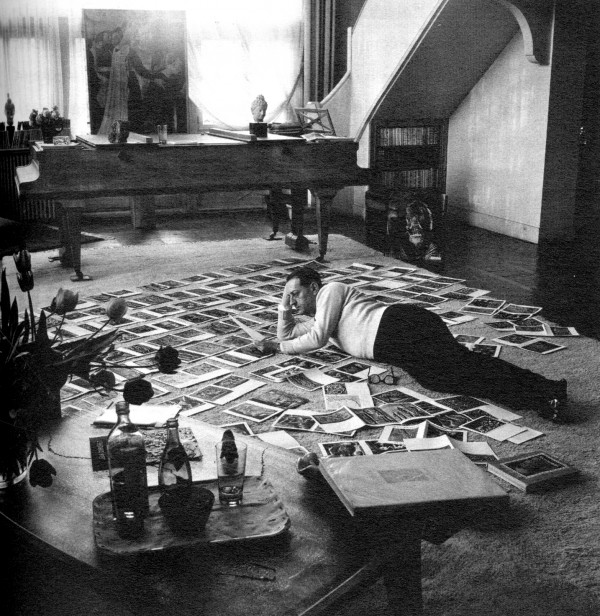
André Malraux chez lui, ©Maurice Jarnoux, Paris Match, 1953.
The notion of recuperation is not part of my work. I do not recuperate anything. There is no commerce with remains, but a problem of supports and vertigo. Or responsibility of the past and transgression of the present. Because what worries me and what may be considered to be a preliminary answer to my question “what is a work of art in a state of global war?”, is the development of spaces that can be qualified as uncontrollable. The uncontrollable, the rupture of controls, the fact that they become impossible.
My rereadings bring into collision (the drama of) the strata of time, precipitating the emergence from this shock of possibilities of creation that defy any prediction of them. In other words, they also allow me to develop an uncontrollable space. The history of the oppressed is a discontinuous history, Benjamin writes, because it is the ruptures of the historic cloth, the uprisings and revolts of the oppressed or, more essentially, the underground tradition of the excluded and the forgotten that bear witness to all the victims of history.
From here we can easily see that the oppressors seek the means to erase all trace of this history.
But if the tradition of the oppressed can become in its own rite the object of a radically different history, this other history that Benjamin defined can only occur or be represented in spaces in accord with this tradition, in other words in spaces that render control by the victors impossible, through historical and positivist reasons. The type of space that I try to manufacture in my dialogues must be put in relation with the uncontrollable. And my last film, The Psychoanalysis of Guy Debord by Freud, made with with Philippe Zunino, comes close to this objective. The DVD will be released in May of this year, edited by the independent Belgian label 68septant, for 20 euros. I specify this because it is important that the editorial decisions of the label, the modest price and the question of distribution be in accord with the film’s content.
E.C.: Can you elaborate on the idea that you write in someone else’s language?
D.L.: I have to find the present in the speech of Dürer’s art language, the present in the speech of Le Corbusier’s art language or the present in the art language of the past in order to extricate it from the sway of art history. Because the present of a work of art is the uncontrollable. Genet expressed this with great precision and accuracy. The only thing a work of art can accomplish is to awaken nostalgia for another state of the work. And that nostalgia is revolutionary. Today, the rupture of controls is the possibility of that nostalgia.
E.C.: To come back to Stéphane Mosès’ work, whose first publication was in 1992, the text marked my own work as an art historian, but also my teaching. Beyond the vision of historical discontinuity, it led me to consider again the idea of dialectic. In this light, I see the idea of “recuperation” as a sort of fiddling with history, dialectical fiddling that allows us to avoid forgetting. A phenomenon described by Walter Benjamin this way: “Any image of the past that is not recognized by the present as being one of its own preoccupations is under threat of disappearing forever.” Concerning your work, it should be noted that you generally use authors who have not been forgotten by history.
D.L.: Yes, it’s an old dramatic strategy from the Medieval tradition of the reversed world. The celebrations of the ass or the mad proposed a dramatic play on the reversal of social and cultural roles. More than parody, they were rites of liberation. One entered into the skin of one’s oppressor in an attempt to live from inside one’s own body the “reality” of the oppressor, but in the form of the grotesque, to try to surmount it and perhaps counter it.
E.C.: Celebrations of idiots, charivaris, public carnivals, comic rites, demonic mysteries, soties (or satirical plays), farces, giants, bouffons, dwarves, monsters. In The Work of François Rabelais and the popular culture of the Middle Ages, Mikhaïl Bakhtine analyzes the role of popular comic culture in the Middle Ages, the importance of play and laughter (and of the people who laugh in the public space). In the introduction he writes: “The festivities revealed the duality of the world. (…) Death and resurrection, alternation and renewal, have always been marked aspects of celebration. (…) They could only be reached through distortion. Celebrations and feast thus became the form that the second life of the people adopted to penetrate temporarily into the utopian kingdom of universality, liberty, equality and abundance.”
D.L.: The body and sociological artist Michel Journiac, who lived in the transmission of beings, taught me this: “To try to live a thought in one’s own body in order to attain truth.” Just like the idiots of the Middle Ages, I go into the interior of legendary artists, both living and dead; I imitate them and transform them into the forgotten, the humble. That is why I say that it is not Fabrice Cotinat who reveals Albrecht Dürer but the opposite: Albert Dürer interprets the role of Fabrice Cotinat. It’s another method of quotation, I would say it was a question of quotation by incorporation.
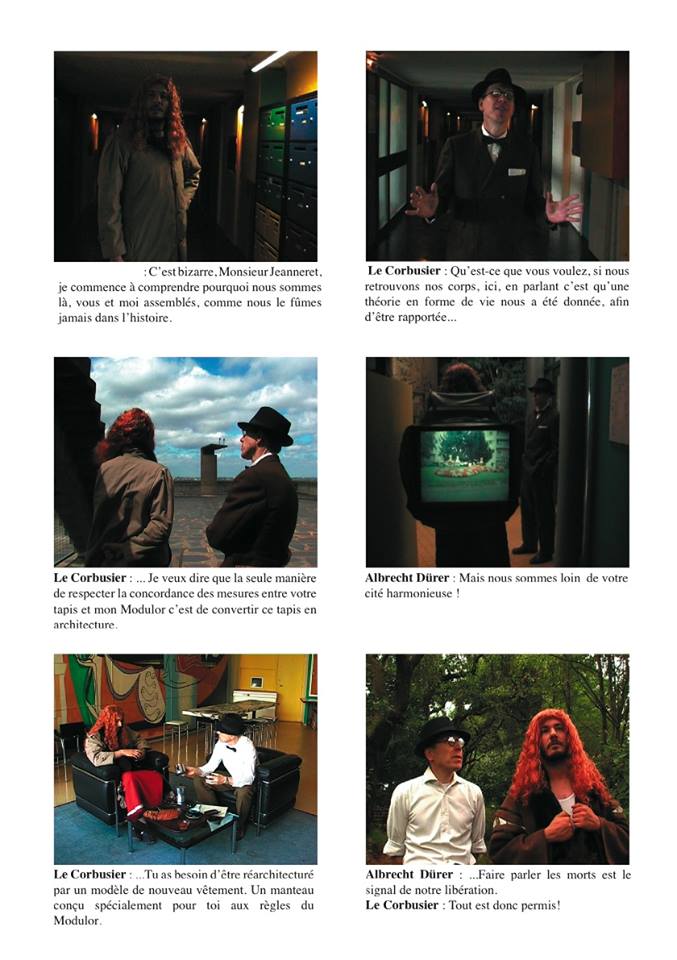
Dialogue fictif n°3 : Albrecht Dürer & Le Corbusier, Michel Aubry / La galerie du cartable, 33’, 2005.
E.C.: Do you practice a sort of lowering (a characteristic of the grotesque), or a transfer of what is elevated, spiritual, ideal, or abstract to the material and corporal? To bring down to earth, to incorporate. By lowering, we bury and we sow by the same occasion, we give death in order to come back to light later, better and more. Negation is followed by affirmation, metamorphosis and becoming.
D.L.: It’s true, when I create a character, it is the common, the discreet, the anonymous or the forgotten parts of the artist of legend that I favor and that I try to reveal in his personal history. And if these traits are not there, I invent them without permission. This gives to our fictional dialogues the impression of seeing Albrech Dürer, Joseph Beuys, Robert Filliou, Pasolini or Warhol for the first time, to rediscover them afresh. The video accentuates this impression, it helps them to lose their “aura”. In the fictional dialogues it is the mediators who transmit things that attach us to their being and not to their art. It is both a sin of idealism, but also a responsibility toward the enormous human catastrophe we are living through. To be clear, the global feeling that we’ve reached the end of a system where life has become a specialized space, essentially toxic, which poisons us and makes us “monoform”…this kills life itself. I call it the capitalization of life or the “monoformisation” of life.
And the critique that we make in our fictional dialogues is neither visionary or prophetic, because this catastrophe is not at all visionary: we’ve always known that it is structural to humanism, or to an excess of humanism, an outrageous humanism. That’s the world we’re in, a world that puts man at the center of the universe and where, as Jean-Marie Straub says: “We put twenty million chickens in bags and bury them to protect humanity.” Obviously, when Straub says this, when he asks those western militants, those inveterate humanists, what right they have to do this, they answer that he is a delinquent… If a Hindou heard them, he would be afraid of them. I think that we are no longer living through the first symptoms of the world, but rather its first agony. That is why we enter inside these celebrities of history, in order to make them live the agony of the work, by trying to surmount the image of an art that decomposes when it becomes the pure servant of a cultural machine. Today, for example and to state it more clearly, the work of art is no longer related to life, but to money and the communicative organization of tastes that it generates.
Making our characters live this disaster, is for example, putting them in a solid social or historical context, living an idea without ever being able to put it outside them. It’s a method for comprehending things so that they speak to us in the language of our time.
Today, making films about the art of my generation comes down to making films about the agony of the work of art by incorporating the language of the grotesque, the blasphemous, the abject and burlesque with the language of the destruction of expression and the collapse of the being, in an attempt to reveal things that have never been said in this chaos. It’s exciting. Searching for old propositions on current questions. Our characters are totems. They incorporate their own failure or disaster in order to surpass art. To give back to common use what had been separated from the people. For Beuys, Warhol, Pasolini it’s clear, when I say people I don’t mean the poor, I mean everyone.
E.C.: In other words to try to provoke an ambivalent, joyous, overflowing, derisive, sarcastic relation, that negates and affirms at the same time, that buries and resuscitates too.
D.L.: In our films in particular, we succeed at celebrating another rite. In an exhibition we don’t. This is not random: there’s culture there! Culture is the enemy. Culture used in this way, never left to breathe, or sing, or be denied or persecuted. And so I use the cultural authority of heroes, of art celebrities to let it breathe, sing, be denied and persecuted. And this also consists in constructing the counter-figure or the opposing figure to artists: the counter-cliche. That’s why they meet: to defend and create “a common work without an artist”.
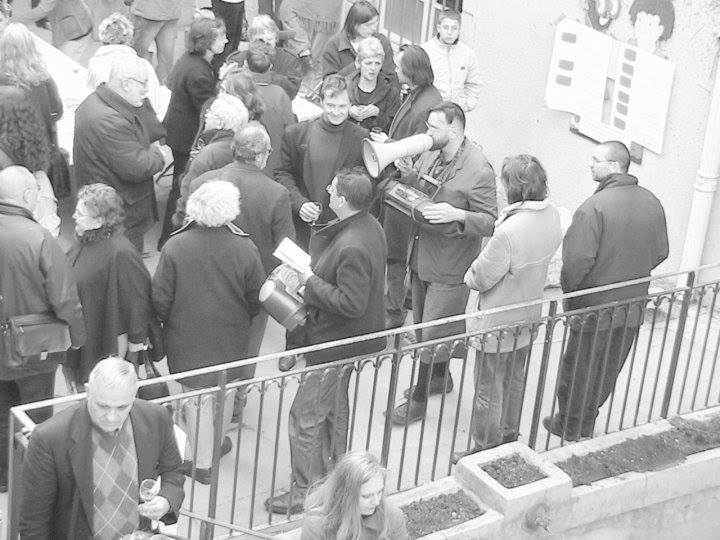
J’aime pas l’art. Action interventionniste du cabaret d’écoutes, David Legrand et Philippe Zunino, Nancy, 2004.
Because I think what has characterized this world for 20 years is called the tyranny of capital, which is itself characterized by the dislocation of everything, the absorption of everything that is public, the disappearance of the common space, the common space between humans, which is the very definition of politics. The disappearance of the public, the public space, the public good. The disappearance of the shared, the separation of each individual with his history, memory, geography. All the images of the public space educate us, they format us to this dislocation, images of capitals proliferate on our walls. Separation-Bondbreaking-Dislocation. It’s for this reason that I hate this thing we still dare to call ART, which has transformed the work into merchandise or luxury products in order to produce distinction, in other words value and not riches for all, because in all liberal logic, this transformation of the work of art into products favors in the first instance those who make it for those who produce it, instead of showing how the people—and I say people—create and renew their own culture by the force of things.
Everything is framed by the empire of merchandise but there is resistance, which creates zones of liberty and solidarity where the power of money and predation has stopped polluting behavior, zones where being wins out over having. The film space of a light cinema, functioning with almost no money, is perhaps the only place that remains concrete and immediate and where we can still experience the non-mercantile artistry of non separation, which is its own definition, the domain of the artistic experience. There where the market exhausts itself emptying us of everything, drying us out, art in general and in the non-mercantile filmic space in particular, repopulates us! Our task is to never stop inventing it, to manufacture it with all the human pleasures it engenders.
E.C.: This critique of culture hides a critique of the bourgeoisie but also of modern formal parody.
D.L.: Yes of course, and this makes me think of the Puglia population that Carmelo Bene speaks of so often in his interviews: a population from the south of Italy who rose up together, alone, and led a communist revolution, at a time when Italy was 90% Christian Democrat, because these local communists had won and the residents really believed that it was a European phenomenon, an international or cosmic one! They set fire to all the houses of the rich. A mess! The local police could not control things. Everyone went to prison. They entered the main church and destroyed everything in it. They occupied the church like the Turkish in Otrante. They went everywhere. With red flags, singing “Avanti, Populo!”, with torches, setting fire to things. Half of the population wound up in jail. It was so very anti-historic, it was completely crazy, even if the people never understood just how crazy they were, nor how beautiful.
This madness, worthy of Don Quixote (except that is was a mass phenomenon), overtook them because they had been duped or swindled of their imagination, of their healthy anti-historicism, if you well, of their ethnicity, because they had been swindled of life! And so at that moment, they wanted to upset history, by denying it, they wanted to live their idea of revolution by becoming the revolution themselves.
When I write, I do not address this people. I believe that I incorporate them when I write (again, a strong link with body art: we still haven’t finished exploring all the potentials of Michel Journiac’s bodily actions as a means of functioning in our current totalitarian democracies). In other words a system of instruments that deprive humans more and more from living the madness of believing that the world remains to be created. The consequence of this is the acceptance of the individual to becoming indifferent to his life. The bio-politics of Michel Foucault announced a body controlled by the state, dispossessed of its interior existence. For example, public powers come to dominate more and more the sexual and intimate life of people, as Lionel Soukaz stated recently in an interview, while individuals no longer exist—what would they have to show—it’s as simple as that. As if the history of their unlived existence unfolded before their eyes, without them realizing that is was their existence and that it had been stolen from them. That is what I call the human catastrophe. Integrating the disaster is bearing it, but it is deathly that such an incorporation transforms the body of man, and thus his thought.
E.C.: Bakhtine again, defined the grotesque realism of the Renaissance in these terms: “In grotesque realism, the spontaneous material and corporal element is a profoundly positive principle, which is neither presented in an egotistical form, nor as removed from other spheres of life. The material and corporal principle is perceived to be universal, belonging to the totality of the people, and it is in this way that it opposes all cut-off from the world’s material and corporal roots, all isolation and confinement in the self, from all ideal abstract character, all pretensions to a detached and independent signification of the land and the body. (…) The spokesperson for the material and corporal principle is neither the isolated biological individual, nor the egotistical bourgeois individual but the people, a people who, in their evolution, believe and perpetually renew themselves.” This is why all the bodily element is so magnificently exaggerated, infinite. This exaggeration carries a positive, affirmative character.
D.L.: And it’s also probably to attain such joy that my characters are mythic, that their appearances in our films absolutely do not respect what they officially represent for history and culture, but rather what they are to us, my friends and I: forces that should not be silenced. I speak from inside them, I translate myself into them. To a certain extent the deceased artists say in these dialogues what people wanted them to keep silent about…I mean their being. Thus the figure of the singular, different, alternative artist, by a state of grace. It’s true! Who would want to resemble a difference? (laughter).
E.C.: Can we awaken the desire for another state of the world without having recourse to a mode tinged with romanticism? By calling on utopia, on the possibility of the existence of a world and a way of thought that accept fragility, inconstancy, subtlety, plurality, contradiction, complexity?
D.L.: Awakening the desire for another state of the world doesn’t necessarily mean having recourse to sadness, but to the language of representation as a whole. For me, representation is the place where my ideas function, a symbolic space where I can live everything, even things that in society would lead me directly to prison. The other state of the world is the site of representation or drama and its force of designation. Edward Bond said that the theater is the only remaining place where he can guillotine God. For me, creating art is the same sort of thing, it’s living the impasse or dead end. In another sense, I don’t want another state of the world because I’m conscious that—in this one—other forms of creation are emerging. For example, I have a young friend who asserts himself as autistic, gay and…artist! His project is to make funerary art videos for Roc-Eclerc, after having written a disabled version of Marx’s ‘Capital’: ‘Paracapital’. In my view, what he has done is also a way of making Armand Gatti, Carmelo Bene, Glenn Gould and Tony Duvert vibrate.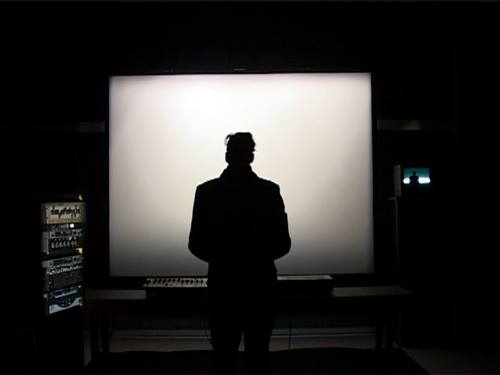
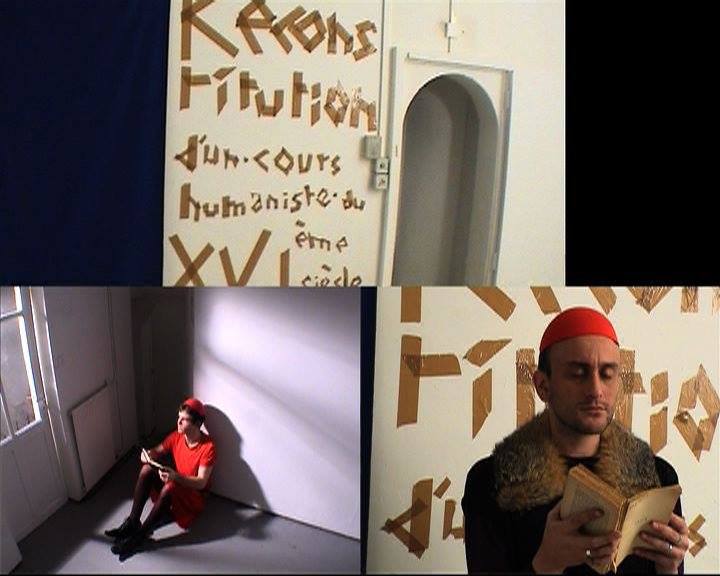
Reconstitution of a humanist course in the 16th century, through the voice of Jean-Luc Godard, David Legrand, 33′, 2011.
LINK TO THE FILM : http://vimeo.com/56773219
E.C.: To come back to the question of pedagogy, which is central to this project. You became interested in the methods of Joseph Jacotot (19th century, University of Louvain) who taught French to his Belgian students by having them read Fénélon’s ‘Télémaque’. These methods are related by J. Rancière in Le Maître ignorant. I was also very interested by the thinking of Paolo Freire. Thoughts that defend the refusal of explication and the work of emancipation, ideas that concern and which are complex to implement. I quote here for the pleasure of it (we can also remove it later) J. Rançière: “Joseph Jacotot believed that all reasoning must originate from facts and cede the path to them. (…) He considered the facts of the spirit acting on his activity as being more certain than any material thing; the fact was that these students had learned to read and write in French without having recourse to his explanations;(…) He left them alone with the Fénélon text, a translation. And their will to learn French… He merely gave them the order to cross through a forest, whose paths he did not know. Necessity forced him to leave aside his intelligence, the mediating intelligence of the master who links the printed intelligence to the intelligence of the apprentice.” (p.19)
“There is nothing behind the written page, no secret compartment that requires the work of another intelligence, that of the ‘explainer’, no language of the master, a language whose words and phrases have the power of imposing reason on the words and phrases of a text. (…) This method of agility was originally a method of will: one could learn independently and without a master to explain if one wanted to, by the tension of one’s own desire or the constraints of the situation. (…) The students had learned without a master ‘explainer’, but that did not mean without a master. Jacotot was master by the command that had kept the students in the circle from which only they alone could remove themselves, by relieving them of his intelligence so that their intelligence would intervene with the intelligence of the book; between the master and the student a pure relation of will to will was established. (…) We will call emancipation the known and maintained difference of the two relations, the act of an intelligence that obeys only itself, even when the will obeys another will. We can teach a subject we are ignorant of if we emancipate the student, if we oblige him to use his own intelligence. To emancipate an ignorant being, one must be emancipated oneself, that is to say conscious of the veritable power of the human spirit: the ignorant person will learn on his own what the master does not know if the master believes he can and obliges him to utilize his capacity.” (p. 20)
“Whomsoever teaches without emancipating stultifies. And he who emancipates need not concern himself with what the emancipated should learn. He will learn what he desires, nothing perhaps. He will know that he can learn because the same intelligence is at work in all the productions of human art, and a man may always understand the speech of another man.” (p.33)
“Such are the effects of the fundamental acts of the master: he questions, he commands speech, that is to say the manifestation of an intelligence either ignored or not used; He verifies that the work of this intelligence is performed with attention, that this speech does not deviate so as to avoid the constraint. This is the secret of good masters: by their questions, they discreetly guide the student’s intelligence in order to make him work, but not to the point of abandoning it. (…) He will not verify what the student has found, he will verify what he has sought.” (p. 51)
How do these questions of a different relation between the diverse actors of instruction and a different relation to knowledge emerge in the film you are making (they were explored in workshops with students through your utilization of a very specific iconography!)?
D.L.: Thanks to Brecht’s technique. Applying Brecht’s technique of the distancing effect in art schools greatly amused me, in the sense of the interest here of the game. Distancing is a technique that allows the spectator to recognize an object at the same time as the object assumes a strange, foreign allure. This is the case with the film “La Visite des écoles d’art”, the title already is a fiction, there is question of staging the schools with their professors, director, students, artists, technicians and personnel with the objective of getting them to ‘practice’ their school by rendering it strange, or foreign, to themselves.
I’d like to insist on the fact that using the distancing effect technique in an institution dedicated to teaching art, by proposing a “fictionalization of the social and pedagogical relations between the past and the present” in the form of a film, led our little research group—students, professors, artist-researchers and by collaboration historians and architects—to have a relation amongst themselves, until it resulted, after a long period of incubation, in a different relation to knowledge; to knowledge!
Of course, it is this process of transformation that will be revealed in the film. For by building this filmed history with a small ‘h’ or, to use the language of dramatic arts, this optimistic fable, is to imagine. To visually show this experience that has never ceased to plead the cause of forms of collaboration, of bringing together or to dream of shared projects between artists (visual artists, architects, poets, videasts, choreographers, musicians) and academics (historians, playwrights, theoreticians, sociologists) in the training of art students, to allow for the flowering of a new school. Which would be today, I believe, an important artistic, scientific and political endeavor. This makes us better understand, perhaps, the role played by history in the construction of our filmed spaces. As in Brechtian drama, it is not a question of ignoring current events, but rather to maintain a to and fro between the past and the present. Historical hindsight or the passage to fiction is a means of approaching difficult subjects without immediately provoking in the spectator reflexes of refusal or emotional adhesion. Which leads to comforting them in their belief and not leading them to question themselves. Of course the use of an iconography of the past, like the one I chose, using painted or engraved images from the 16th century to “improvise” with students with the means at hand, the set, accessories and costumes for the “Reenactment of a humanist class” or the use of military uniforms from the late 19th century, faithfully reconstituted by Michel Aubry, mixed with those of anti-historic invention, conceived of and made by students in “La Visite des écoles d’art” are elements of the work of transposition of the past into the present, which creates a historical present that does not offer explanations, but exposes dilemmas, in such a way as to nourish a problematic of transmission.
To conclude on this question, I think it is essential that all work undertaken with an art school also confirms the teaching of art as a place for the experimentation of its history, its representation and its transmission. In this way the fiction or the “fable” that is built and that emerges from the reality of a school functions as a second reality, made up of this work as much as it is from the memories or fantasies of students and professor and the desire of directors. Otherwise, there would be no flesh on these images.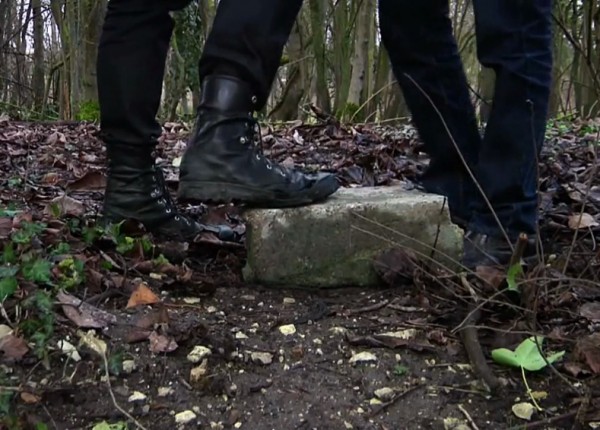
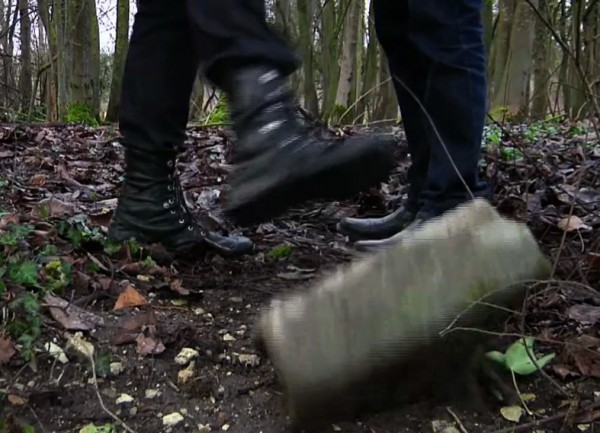
Profanation des dispositifs, David Legrand and Philippe Zunino, 26’, 2013.
LINK TO THE FILM : http://vimeo.com/69510444
E.C.: To come back to the film (“La Visite des écoles d’art”), could you present Commandant von Stroheim to us and the manner in which you conceived his charatcer and his performance?
D.L.: Commandant von Stroheim is a combination of the great filmmaker and director Erich von Stroheim, the eccentric cinema actor he was and the role of the Commandant von Rauffensteing from Jean Renoir’s “La Grande Illusion”. When I created this character I wanted to give myself a large palette that contained all the facets of the character, of Stroheim becoming a sort of synthesis of his history, his renaissance, his Frankenstein. The synthesis of Stroheim also offered me the possibility of introducing pedagogy into art: a pedagogical creature.
— In art schools or in an exhibition situation, another idea of performance
— actor’s play
— the introduction of the cinema actor into real life
— My taste for disguise, metamorphosis, esotericism, my acting via imitation.
— Simulation, disguise, metamorphosis
— The very essence of theatrical acting
— Imitation and only imitation
— Representation of mass
— Religious theater
— I learned theater during the celebration of rites at church.
E.C.: Could you give precise examples of scenes from the film with structural elements (and in this way circle back to the operetta, for example)?
D.L.: For “La Visite des écoles d’art”, it is both a film, but also a school program that could only be made via fiction and an immense performance in art schools.
E.C.: but also the conditions of the shoot…
— specify the roles of Godard, Catherine Jourdan, concrete music…in open climates and the film
— and to evoke the editing of the film…
Emmanuelle Chérel :
With a PhD in Art History, authorized to direct research, member of the research laboratory ‘Languages, urban actions and otherness’ at the Ecole Nationale d’Architecture in Nantes, Emmanuelle Chérel works more specifically on the political dimensions of art. After studies in geography, sociology/anthropology and art history, she favors interdisciplinary approaches and tools as a way to reposition an artistic proposition in its context of appearance to observe it character as ‘accomplished act’ with an historic reality.
A professor of art history at the Ecole supérieure des Beaux-arts in Nantes, she is the head of a research project there, ‘Pensées archipéliques’. Emmanuelle Chérel has participated in different group research projects and symposiums and has written many articles, amongst which “X et Y/ contre préfet de… Plaidoirie pour une jurisprudence – une proposition d’Olive Martin et de Patrick Bernier”, Multitudes N°52, “Défigurer la figure: Latifa Lâabissi”. Journal des Laboratoires d’Aubervilliers and has shared a position as codirector with Elisabeth Pasquier of La fiction et le réel, Lieux Communs N°16. Her work “The Memorial of the abolition of slavery of Nantes—Stakes and controversies” (PUR, 012) retraces and analyzes the genealogy of this project. She is currently working on a new book titled, “Where are we in France concerning the postcolonial question in the field of art?”
David Legrand is an agitator. For 20 years he has upset ideas and group practices, perturbed schools and well established rules, reactivated freshness and insurrectional practices in the tradition of avant-gardes. His physical engagement is total, whether as inspired actor in action performances or instigator of film experimentation in new domains. He began his artistic activities with Fabrice Cotinat and Henrique Martins-Duarte with their ‘galerie du cartable’, but has since worked frenetically with many singular artists, such as Rainier Lericolais, Michel Aubry, Philippe Zunino, Michel Giroud, Chus Martinez, Joseph Morder or Boris Lehman, becoming a veritable accomplice of the latter. He has always been passionate about investment in extraordinary work and contexts, whether it be with the supporting and interventionist ‘galerie du cartable’, the epic fictional dialogues with the greats of art, or in the experimental programs of alternative and tactile media, such as the recent platform Video Performing Art, which he coordinated for the latest international encounters Bandits-Mages. Ewen Chardronnet

